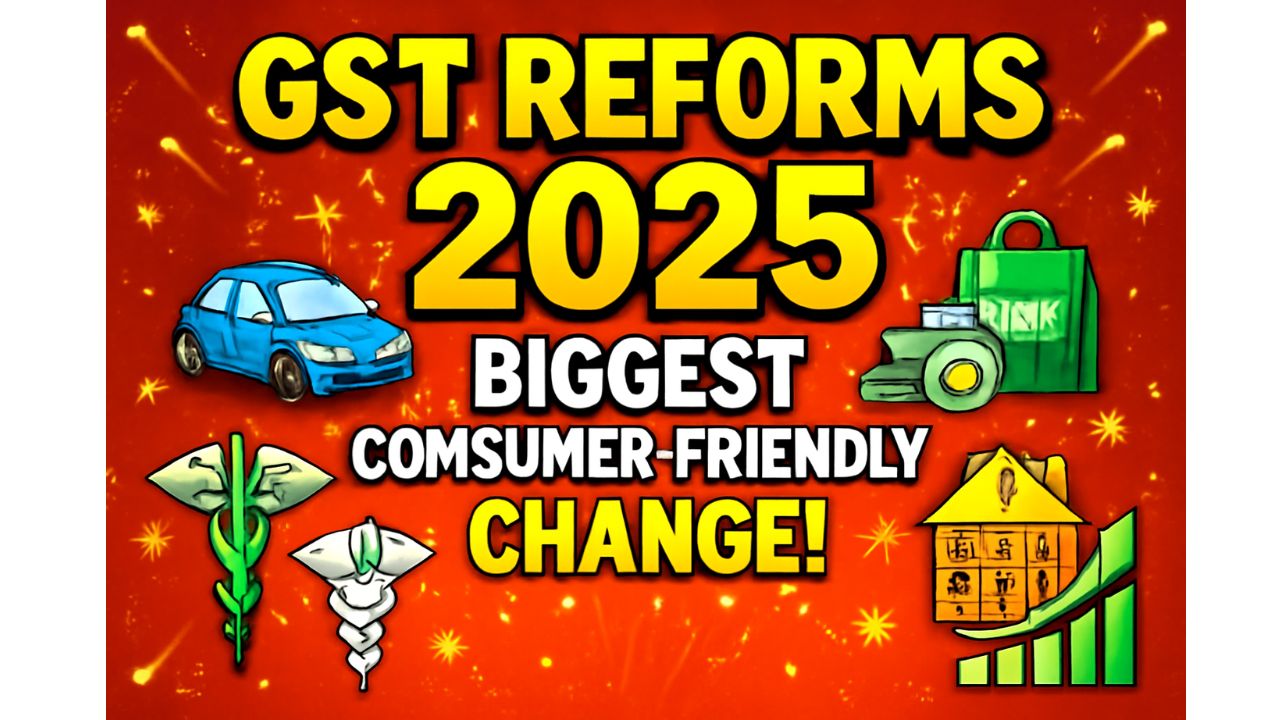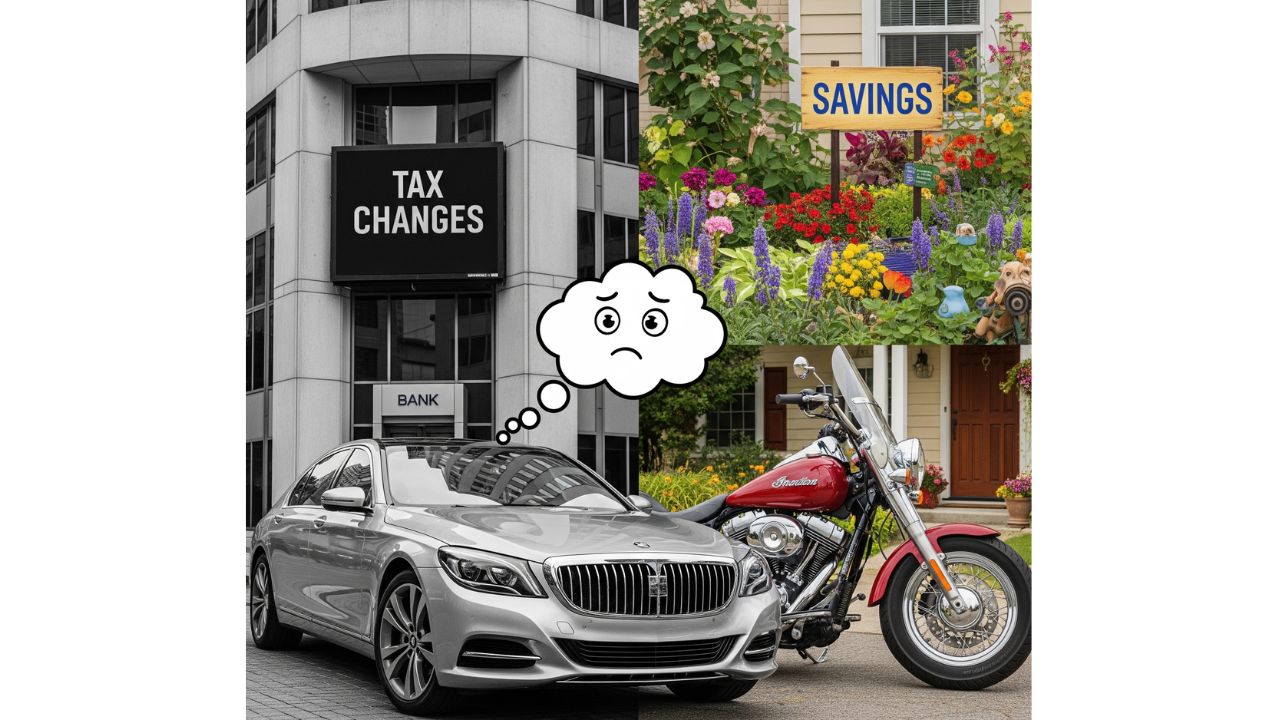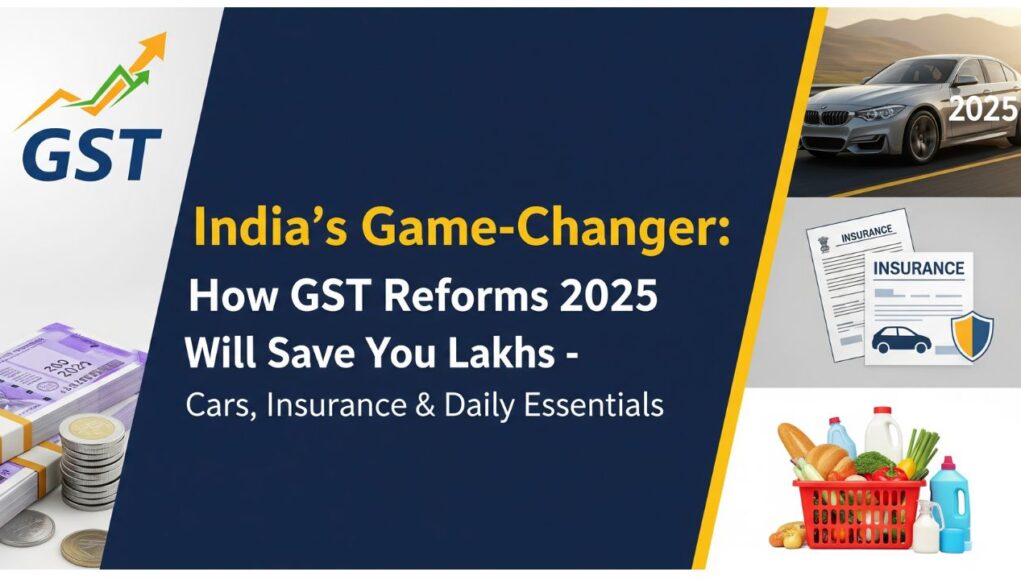GST Reforms 2025 is assume to be the India’s biggest consumer-friendly reform. This is not just a tax simplification but also a direct saving engine that will gives the benefit to all the middle-class, rural and urban consumer. so, Let’s understand the breakdown of each and every sector in detail – with example, how much benefit you will get, and what will be the long term impact on the stock market and GDP of our country.
🚗 Automobile Sector – The biggest Jackpot
The biggest winner of the GST Reforms 2025 is quite clear and it is – Automobile industry. In this reform, rate cut looks so significant that buying small car, 2-wheeler or mid-segment SUV has become festival offer for the buyers.

🔹 Small Cars & Bikes – Direct Relief
- Earlier GST: 28%
- Now GST: 18%
- Meaning every buyer get a flat discount of 10%.
✔ Example – If you are going to buy a 10 Lakh petrol car then:
- Old Price: was ₹10,00,000 (28% GST included)
- New Price: is ~ ₹9,20,000 (18% GST ke sath)
- Net Savings: ~ is ₹80,000 (8–9% cheaper than the earlier)
✔ If you are considering a little premium diesel car worth Rs 15 Lakh:
- Old Price: was ₹15,00,000
- New Price: is ~₹13,50,000
- Net Savings: is ~ ₹1.5 Lakh (close to 10%)
👉 Meaning it is the perfect timing to purchase a car – whether it is hatchback ho ya compact SUV, buyers will get the direct benefits of lakhs.
🔹 Two-Wheelers & Scooters – Mass Market Boost
- Scooters and commuter bikes like Honda Activa, Bajaj Pulsar, Royal Enfield Classic (<350cc) now get ~10% cheaper than the earlier.
- A big relief for the rural and middle-class buyers because 2-wheeler is quite essential item in every household in India.
🔹 Luxury Cars & Big Bikes – Limited But Noticeable
- Earlier Effective Tax (GST + Cess): ~45%
- Now: Flat of 40%.
- This means some relief is also provided fro the premium SUVs and 500cc superbikes buyers – means the saving would be in lakhs, but the percentage cut is limited as compare to the smaller cars.
💡 Overall Impact
- There is going to be a solid boost in the demand of car and bike in the upcoming festival season like Navratri & Diwali.
- There is also a possibility to get jump in the sales volume of the auto companies (Maruti, Tata Motors, Mahindra, Hero Motocorp, Bajaj Auto).
- With the reduction of the handling cost for the middle class buyers, it also become easier to adopt the financial and EMI adoption.
🏥 Healthcare – Zero GST Revolution
Healthcare sector is also assumes to be the biggest winner of this reform because now in Healthcare sector:
- Life & Health Insurance: Earlier 18% GST, but now 0% GST apply on any healthcare service.
- Example: Earlier, If the premium is ₹50,000, so there was an extra GST of ₹9,000 but now there is the direct saving of ₹9,000.
- Cancer & Life-Saving Drugs: Now absolutely Zero GST.
- Generic Medicines & Thermometers: Tax rates have been reduced.
👉 It has two benefits –
- Now Ordinary middle-class families doesn’t hesitate to take the insurance (because now the premium is very less).
- With implementation of this, Treatment cost will be reduce (specially for life-threatening diseases).
💡 Long-term impact: Insurance adoption will be increase→Insurance companies (HDFC Life, SBI Life, ICICI Lombard) will get direct benefit. And there may be chances that aggressive growth can be seen in the pharma and hospital stocks.
🏠 Real Estate & Cement Sector
- Earlier, there is a GST of 28% on the cement, but now it has been reduced to 18%.
- If you take the cement of worth ₹10 Lakh, then the same quantity you get it now with just ~₹9 Lakh, which seems to be quite good for the middle-class.
Impact:
- The cost of building the houses, property construction and infrastructure project will going to reduce.
- The demand for the Real estate will not increase artificially because people will not buy the house earlier because of the GST cut, but after this, the running project cost will definitely reduce.
- Cement companies will also get the benefit and demand will also become stable, which is a plus point.
📦 FMCG & Daily Essentials
The biggest change has been seen on the Daily use items:

- Shampoo, creams, toothpaste, soaps, shaving cream, hair oil – Now 18% reduce to just at 5% GST.
- GST also reduces on Chocolates, coffee and processed foods.
Example:
- Earlier a shampoo of worth ₹200 was available on ₹236 and now on just ~₹210-212.
- Meaning for a family, upto ~₹1000 can be saved per month.
💡 Market Perspective:
- Margin of the FMCG companies (HUL, Dabur, Nestle) may improve → stock prices will move in the positive direction.
📺 Electronics & Appliances
- TVs, ACs, Fridges now have 18% GST (earlier in high slabs).
Example:
- Earlier, a fridge costing ₹30,000 would be cost ₹35,400 with the GST.
- Now the same fridge comes around ₹33,500.
👉 The electronics and appliances demand will be high in the festival season and volume of growth of these companies also remain stable.
🏨 Hotels & Agrochemicals
- Hotel with lower tariff are now in low GST slab. This is quite benefit for the mid-range travelers.
- GST has been reduced from 12% to 5% on the Agrochemicals & fertilizers.
- With the reduction in the input cost of the farmer, rural demand for the FMCG and 2-wheelers will further improve.
📊 Impact on 12 Key Sectors
| Sector | Impact | Direct Benefit |
|---|---|---|
| Insurance (Life + Health) | biggest positive | Premiums are low, adoption high |
| Automobiles | Strong growth | Saving of ₹80,000–1.5L on Cars & bikes |
| Farm Equipment | Rural boost | Tractor sales increases |
| Cement | Infra cost cut | House builder will benefitted |
| FMCG | Margins improve | Consumer saving + extra spending |
| Electronics | Festive demand | White goods will slightly cheaper |
| Food & Beverages | Positive | Ghee, namkeen will be cheaper |
| Pharma & Healthcare | Industry unlock | zero GST on Drugs |
| Hotels | Mid-range advantage | Domestic tourism will get the push |
| Agrochemicals | Farmer support | Fertilizer cost will reduce |
| Kitchen Utilities | Lower prices | Utensils, chimneys |
| Luxury Cars/Bikes | Limited relief | GST ~45% → 40% |
📈 The Impact on GDP – Long-Term Growth Story
🔹 GDP Impact
GST reforms 2025 is not just only consumer savings tool, but also a economic growth accelerator.
- FY2026 (Immediate Impact):
Expert estimated that this reform will provide a direct boost of approximately ₹25,000 Crore, which is 0.1% of the GDP. . This short-term number may seems to be small, but they create a solid base to kick-start the consumption and investment cycle. - FY2027 & Beyond (Sustained Impact):
As when the consumer saving convert into the demand and business grow their margins, then it is estimated that the benefits of this reform would reach ₹2 Lakh Crore+. This would mean additional growth support of 0.5%–1% in GDP – which is a big step towards the India’s $5 Trillion economy target.

✅ Final Conclusion
GST Reforms 2025 is consumer-centric game changer. In short-term, we can say that stocks remain volatile but in long term, you will get the benefits the most from these three areas.
- In buying a Car – Direct saving of lakhs.
- In buying the Insurance – the premiums is quite cheaper.
- In the Daily essentials FMCG shopping – get a big relief in the monthly household budget.
This reform will make the whole taxation framework much simplified and also a growth-oriented. Now the middle-class consumer get some saving and in long term demand cycle, business will also boost.












